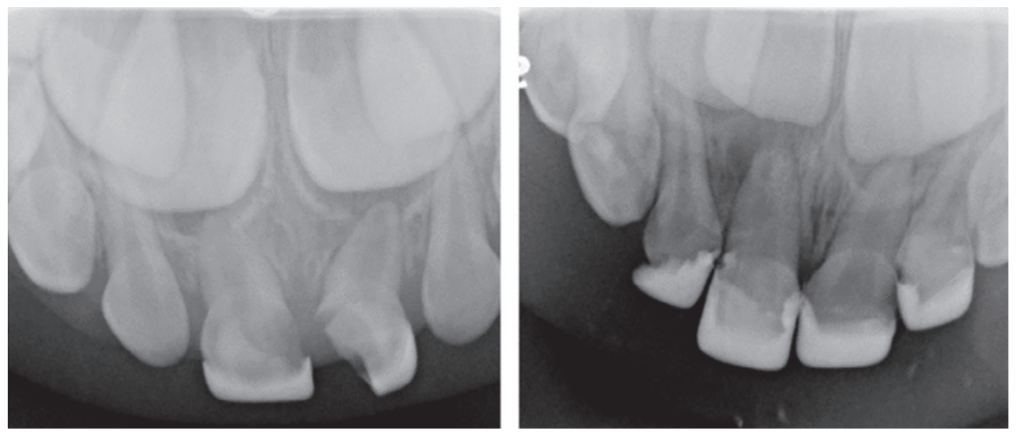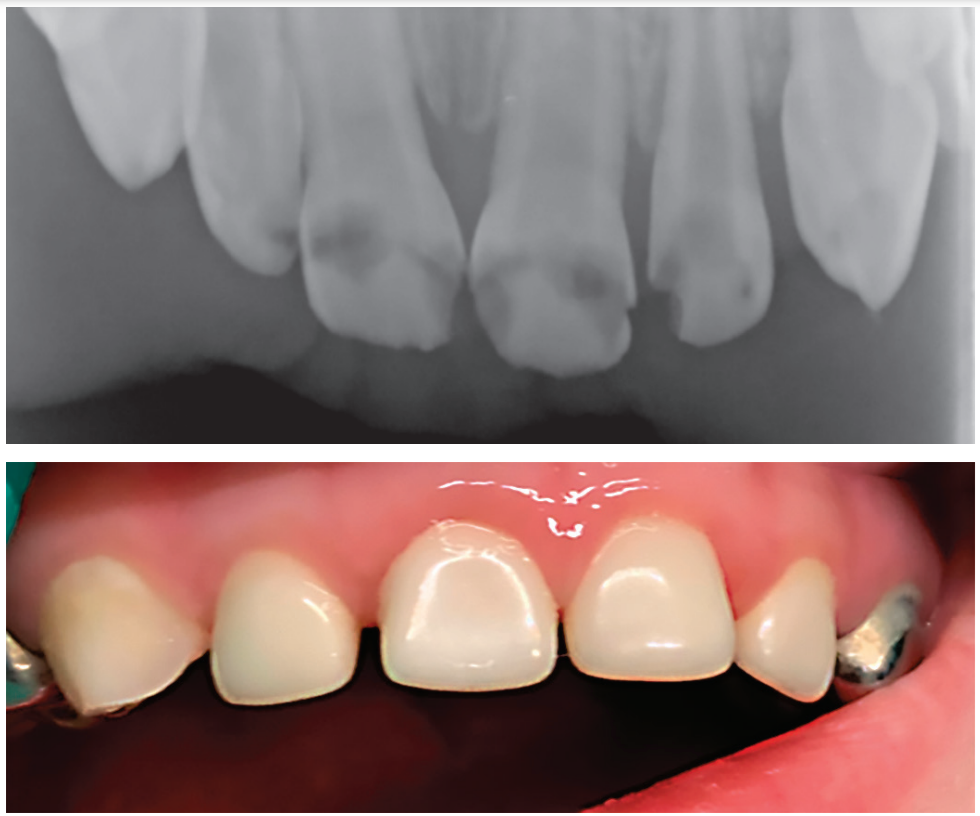The rationale for full coverage esthetic crowns: a case series
Dr. Patrick Ruck talks about complex pediatric dental issues and severe childhood caries and how NuSmile® ZR Anterior Crowns provide an esthetic, highly biocompatible, and long-lasting restorative solution.

Beyond esthetics: Dr. Patrick Ruck discusses NuSmile® ZR Anterior Crowns as a long-term solution for complex pediatric dental cases
Background
Several clinical solutions exist for primary anterior teeth with multisurface decay. Full coronal restoration of carious primary incisors may be indicated when caries is present on multiple surfaces, pulpal therapy is indicated, caries may be minor, but oral hygiene is very poor, or in a child with severe early childhood caries or a high caries risk diagnosis.1 Depending on the clinical scenario, a minimally invasive approach with the utilization of a high viscosity glass ionomer cement (HVGIC), with or without the combination of silver diamine fluoride (SDF) in a strip crown form, may pause the caries progression and provide an adequate clinical solution. Resin composite strip crowns have shown 80% retention rates and adequate parental satisfaction,1-4 although composite resin strip crowns have shown lower retention rates in teeth with decay involving three or more surfaces and particularly in children with a high caries risk4-6 (Figure 1). This could be from the continued high caries risk behaviors of the patient, as composite resin strip crowns in this population have shown to have increased inflamed marginal gingiva and gingival bleeding, increased plaque retention along the restoration, and loss of some restorative material.5,6

Alternatively, a resin-faced stainless steel crown provides a full coverage restoration with excellent retention.7 These crowns can serve as a full-coverage restoration with or without the resin facing, but the loss of resin facing can be a major esthetic concern for parents.7 Preformed pediatric zirconia crowns address many of the undesirable clinical outcomes of other restorative materials. Their biocompatibility, demonstration of excellent marginal gingival health, low plaque retention, high parental esthetic acceptance, and high survival probabilities make them an excellent clinical choice in the patient with severe early childhood caries.1,4,5,8-13
With parental interest increasing in esthetic treatment options for complex anterior caries, preformed pediatric zirconia crowns are becoming the treatment of choice for patients with a high caries risk or a severe early childhood caries diagnosis.14 This review discusses three clinical cases in which NuSmile® ZR (NuSmile, Houston, Texas) anterior pediatric zirconia crowns were the correct clinical decision in varying clinical scenarios.
Case 1
A 2-year-old male who received full mouth dental rehabilitation (FMDR) under general anesthesia presented for his 6-month recall at 2-year post FMDR. He had significant plaque accumulations with poor oral hygiene along his existing stainless-steel crowns (SSCs) and non-treated teeth. Additionally, the patient had gingival bleeding and gingival inflammation around these clinical sites. His anterior zirconia crowns showed healthy gingival margins with little-to-no plaque accumulations. This positive clinical finding is from the highly polished nature and biocompatibility of pediatric zirconia crowns. These restoration features limit plaque accumulations on the restoration and along the marginal gingiva, providing a localized positive aspect directly related to the choice of restorative material (Figure 2).

“With parental interest increasing in esthetic treatment options for complex anterior caries, preformed pediatric zirconia crowns are becoming the treatment of choice for patients with a high caries risk or a severe early childhood caries diagnosis.”
Case 2
A 3-year-old female presented with pulpal necrosis and abscess on #E and pulpal necrosis on #F. Extraction therapy or pulpectomy was offered. The family was highly motivated to retain #E and #F. The pulpectomy was performed with 0.02 K-Flex hand files, 3% NaOCl with a lateral vented needle, obturated with Vitapex (Neo Dental International Inc., Federal Way, Washington), a premixed paste of calcium hydroxide and iodoform. The access was filled with a HVGIC sealing the pulp therapy and increasing the clinical success by minimizing the potential for bacterial contamination. NuSmile ZR anterior crowns were selected as offering a full-coverage, esthetic, cemented restoration with no polymerization shrinkage when compared to a composite restoration. Crowns were cemented with NuSmile® BioCem (NuSmile, Houston, Texas). This is clinically beneficial as the provider would want to cement a restoration that provides limited microleakage minimizing the potential for bacterial contamination.15-17 At 6-month follow up, lesion healing had occurred with healthy gingival margins and no plaque accumulations (Figure 3).

Case 3
A 4-year-old female presented with existing Silver Modified Atraumatic Restorative Technique (SMART) style restorations on #D, #E, #F, #G, and caries on other teeth. These anterior lesions had been previously treated using SDF and covered with a HVGIC in a strip crown form. Though her lesions were stable from the clinical success of the SDF and HVGIC, these restorations were starting to fracture and demonstrate loss of material. The family wanted a more esthetic treatment option that would have a longer survivability. Additionally due to her high caries risk nature, a full coverage restoration with NuSmile® ZR anterior crowns were a more ideal solution in stabilizing her extensive decay pattern and covering staining from SDF therapy (Figure 4).

Conclusion
There exist multiple treatment solutions, but NuSmile® ZR anterior crowns provide a highly biocompatible, long lasting, and esthetically pleasing restoration. This is an excellent clinical choice for the high caries risk patient with severe early childhood caries.
 Patrick Ruck, DDS, is an assistant professor at Cincinnati Children’s Hospital Medical Center. He can be reached at patrick.ruck@cchmc.org.
Patrick Ruck, DDS, is an assistant professor at Cincinnati Children’s Hospital Medical Center. He can be reached at patrick.ruck@cchmc.org.
Disclosure: Dr. Patrick Ruck is a known opinion leader (KOL) for NuSmile.
- American Academy of Pediatric Dentistry. Pediatric restorative dentistry. The Reference Manual of Pediatric Dentistry. Chicago, Ill.: American Academy of Pediatric Dentistry; 2023:443-456.
- Ram D, Fuks AB. Clinical performance of resin-bonded composite strip crowns in primary incisors: a retrospective study. Int J Paediatr Dent. 2006 Jan;16(1):49-54.
- Kupietzky A, Waggoner WF, Galea J. The clinical and radiographic success of bonded resin composite strip crowns for primary incisors. Pediatr Dent. 2003 Nov-Dec;25(6):577-581.
- Sharma M, Khatri A, Kalra N, Tyagi R. Comparison of parental satisfaction with strip crowns and primary anterior zirconia crowns in 3-5 years old children over 1 year. J Indian Soc Pedod Prev Dent. 2021 Oct-Dec;39(4):423-428.
- Alaki SM, Abdulhadi BS, AbdElBaki MA, Alamoudi NM. Comparing zirconia to anterior strip crowns in primary anterior teeth in children: a randomized clinical trial. BMC Oral Health. 2020 Nov 10;20(1):313.
- Amin M, Nouri MR, Hulland S, ElSalhy M, Azarpazhooh A. Success Rate of Treatments Provided for Early Childhood Caries under General Anesthesia: A Retrospective Cohort Study. Pediatr Dent. 2016;38(4):317-324.
- Lopez-Loverich AM, Garcia MM, Donly KJ. Retrospective Study of Retention of Stainless Steel Crowns and Pre-veneered Crowns on Primary Anterior Teeth. Pediatr Dent. 2015 Nov-Dec;37(7):530-534.
- Verma RK, Srilatha V, Patel S, Dithi C, Somaraj V, Vallabhaneni SK. Assessment of Parental Satisfaction with Various Aesthetic Crowns Among Children of Various Age Groups: An Original Research. J Pharm Bioallied Sci. 2023 Jul;15(Suppl 1):S196-S200.
- Ajayakumar LP, Chowdhary N, Reddy VR, Chowdhary R. Use of Restorative Full Crowns Made with Zirconia in Children: A Systematic Review. Int J Clin Pediatr Dent. 2020 Sep-Oct;13(5):551-558.
- Alrashdi M, Ardoin J, Liu JA. Zirconia crowns for children: A systematic review. Int J Paediatr Dent. 2022 Jan;32(1):66-81.
- Vaghela LL, Patel MC, Bhatt RK, Patel CN, Joshi KR. Clinical Performance and Parental Satisfaction with Composite Strip Crown and Prefabricated Zirconia Crown for Primary Anterior Teeth: A Randomized Clinical Trial. J Contemp Dent Pract. 2021 Dec 1;22(12):1462-1470.
- Holsinger DM, Wells MH, Scarbecz M, Donaldson M. Clinical Evaluation and Parental Satisfaction with Pediatric Zirconia Anterior Crowns. Pediatr Dent. 2016;38(3):192-197.
- Seminario AL, Garcia M, Spiekerman C, Rajanbabu P, Donly KJ, Harbert P. Survival of Zirconia Crowns in Primary Maxillary Incisors at 12-, 24- and 36-Month Follow-Up. Pediatr Dent. 2019 Sep 15;41(5):385-390.
- Gosnell ES, Thikkurissy S. Management of dental caries and esthetic issues in the pediatric patient. J Calif Dent Assoc. 2013 Aug;41(8):619-629.
- Stepp P, Morrow BR, Wells M, Tipton DA, Garcia-Godoy F. Microleakage of Cements in Prefabricated Zirconia Crowns. Pediatr Dent. 2018 Mar 15;40(2):136-139.
- Iampinitkul S, Chaijareenont P, Chinadet W, et al. Microleakage of luting cements in CAD/CAM pediatric zirconia crowns: An in vitro study, 05 February 2024, PREPRINT (Version 1) available at Research Square [https://doi.org/10.21203/rs.3.rs-3896630/v1]
- Walia T, Brigi C, Ziadkhani MM, Khayat AA, Tabibzadeh Z. Retention Force of Glass Ionomer Based Luting Cements with Posterior Primary Zirconium Crowns – A Comparative in Vitro Study. J Clin Pediatr Dent. 2021 Oct 1;45(4):259-264.
Besides finding out about NuSmile® ZR Anterior Crowns, read more about how NuSmile is helping to reduce pain and fear in patients at Dr. E. LaRee Johnson’s pediatric practice. https://pediatricdentalpractice.com/using-innovation-to-create-a-dental-home-for-all-children/
